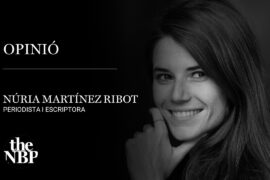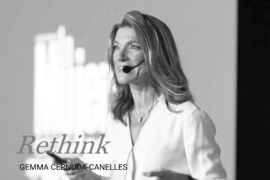
The unremitting human emancipation from nature –transformed into “culture”– is...

The first session of the cycle on the regatta organized...

The Earth from space, those other corners of the universe,...

You would never say that Mari Carmen Tous is 85...

Its first 'boutique' in Barcelona will open on the ground...

The direct relationship between intelligence and success applies to any...

Graduated in Biological Sciences from the Universitat Autònoma de Barcelona...
In hospitals, besides managing health, they manage life and death...

We forget songs, loves and trips. Maybe, because they did...

The textile company that designs, manufactures and markets accessories for...

Música clásica sobre la arena de la playa en dos...

The first session of the cycle on the regatta organized...

The hospital's managing director, Manel del Castillo, and the pharmaceutical...

Generalitat y Ayuntamiento impulsarán dos equipamientos de 'Casa de les...

Leticia Beleta, director of Alexion Pharmaceuticals in Spain and Portugal,...

We all have a friend who never leaves the Gràcia...

Barcelona director opts for Best International Film with 'La sociedad...

The hotel and industrial sectors softened the market's decline last...

The technology company, with a workforce of 35 employees and...

“The women of yesteryear were strong and had to fight...

[dropcap letter=”M”]
oving is the habit of counting changes according to centuries. Progress, the great leap forward, before and after. One hundred or one thousand, rounded up figures for egg-shaped inhabitants of an oval-shaped sphere-like planet. What will the world be like by the year 2100, on the gateway to the next century? And the present one, will it be long or short? ¿Short like the 20th century, according to Hobsbawmites, or long like the 19th century, that of the Industrial revolution, which began towards 1760, when hand-made products came to be made by machines? For the time being, it seems that the 21st century started moving on time, at their precise date and time: on a Tuesday, 11th September of 2001, between 8.46 and 9.03 h. The departure of the new century took place within these 17 minutes, between the crash of the first plane against the North Tower and the second plane hitting the South Tower of this building in one of the districts of New York, the old World Trade Center. This is not a metaphor: the WTC had so many companies, public and private, registered in this location that the WTC had a postcode of its own. Seventeen minutes: this is the duration of time needed for those who reported the event —tv commentators forced to interrupt their daily purr and give way to live footage recorded by CCTV cameras from the Empire State, joined later by those of other nearby buildings, in Manhattan and Jersey, and helicopter takes— to say the word terrorism. While the 19th century ended and the 20th began with the Great War, we have admittedly moved on: from 4 years of killings and 17 million deaths to 17 minutes and 2,871 DNA-identified bits. There are still those who complain: it is difficult to admit that I belong to the shortest and least bloody century.
While this century that began with the best auspices will soon reach the year 2100, is of little relevance. Neither is it relevant how it will end. Why? Because nothing ever ends, and, clearly, our timings are fantasies sharing the same purpose as a lullaby: allowing us to sleep every night, cozily wrapped up in our welfare fantasies or trapped in a nightmare that makes us feel grateful when we wake up, and happy in the belief that we are masters of our own fate. The planning of the past is sometimes not that distinguishable from our forthcoming future plans: hardly does it change, and not always, in terms of fictional causes. For example, the climate change. Ever since the existence of recorded climate variations and their interpretation, we know that planet Earth has gone through several ice ages and warmings. Only recently, since the 1960s, have we introduced another variable in the explanation of their causes: anthropogenesis. Our domineering “doxa” indicates that we are prone to living in a world of high temperatures —resulting in scores of apocalyptic evils: melting glaciers, rising sea levels, disastrous floods and drought— of which human interaction with the environment is to blame. Those factors that have had an impact on global warming, such as the sun’s activity, have been wiped out entirely from the narrative. The point is that legions of believers in the thesis of anthropogenic global warming, capable of imagining the year 2100 in line with this fashionable fiction, are not even conscious that they do that as forcefully and ardently —like crusaders or yihadists— just like their precursors: hardly four decades ago, they would promise a similar terminal future for a similar reason —our ominous and all-powerful activities over the environment— but this one has an entirely opposed effect: a new ice age capable of obliterating all life form on the planet. Had those learned fortune tellers guessed that this moment, in summer 2016, if I were not dead yet, I would be writing this article in a basement, wrapped up inside a dozen blankets, gloved hands and, of course, not writing in a computer but under the uncertain light of an old lamp. Even such well-furnished heads as Bertrand Russell’s projected three scenarios, in The Future of Man, two of which are apocalyptic and postulate consequences similar to those of a new ice age, except those caused by nuclear nightmare come true: the destruction of all forms of life on the planet, or, optimistically, a massive involution to primal life forms caused by a catastrophic decrease in the number of inhabitants. When Russell published this paper, in 1961, there were less than 3,000 million human beings; nowadays, there are 7,000 million inhabitants on planet Earth.
The key to this type of fictions is the exaggerated role of their authors… for themselves. Anthropogenics is precisely what is extraordinary about the theory of global warming. In turn, this is blatantly religious: since us, and only us, are guilty of our own misfortunes, we have no choice but making an act of contrition, atone our own sins and amend ourselves, should we aim to achieve this state of blessed perfection in which we will live once we reconcile with nature. Borges wrote, in one of his fantastic narrative poems, that “the artifice and candor of man go on without end”. Candor, above all. And this is the real driving force. Those who manage to think this way and imagine this one or any other apocalypsis at their reach, those people are, deep inside, worth admiring. Fictions confused with realities have their origin in an endless mixture between ignorance and faith, the driving force of all religions, from the past, the present and the future. Another “prophet”, one that still has his own acolytes –and many of them— dared to postulate, in the 19th century, a near future where religion would be “the people’s opium”, and would disappear when it would no longer be necessary. “The people” would live under the shiny truth of a class-free society. Another fiction, converted, thanks to time —thank you, irony of history!— into a new religion. Equally filled with superstitions and myths, as fallacious and bloody as the others, the real ones. Some insist on calling that “progress”.
But progress just happens to exist. It is more complex, though and less easy to control. Of course, progress takes place independent of our judgment of values. To put an end to anthropogenic warming, it is enough to argue from evolutionism, as the paleonthologist —holding an admirable surname— C. K. Brain says: “It is not unreasonable to conclude that, had it not been for environmental climate changes in habitats of the early hominids, we would still be safe in some warm and cozy forest, like in the Miocene, and would still walk on tree tops”. Being astonished at climate change is then sheer ignorance. From this astonishment, postulating an apocalyptic future means positioning faith in the wrong place. We may see the day when humans will have wiped out all the plants and animals on the planet, but, by the same token, they will have also found a way of evolving.
Of all the outlooks or predictions of this youthful 21st century, which still lacks the age needed to achieve reason, there is one I consider essential. I mean that any other, including the deadly effects of global warming for life on the planet, pales by comparison. Among other reasons, because this is the only one that allows being interpreted as utopia or dystopia. This is, from this viewpoint, perfect fiction.
Give or take, fiction argues that in a not too far future —let us say, for the sake of keeping the original convention of this article, in 2100— thanks to technological applications deriving from advances in genetic engineering, neuroscience, cryogenics and other sciences and technologies, human beings will be able to bridge the only obstacle that has prevented us from our evolutionary progress. Death will stop being the inevitable end of life, and its duration will be extended endlessly. After post-colonialism, post-communism, post-democracy; after post-gender of the queer theory, with its fantasy that denies genetics and postulates the ultraculturalist fiction that I am the one who decides my sex and how I want to change it, just like one can change the colour of one’s hair dye or buys a pair of new shoes. And, talking about post-racism of the NGO that manage and also benefit from migrations, there is only one masterpiece left in this jigsaw puzzle of artifice and candor: post-death. Certainly, it is noticeable that some of the most eloquent advocates of this fiction are the evolutionists. It seems that they have ignored the fact that, should their dream come true and biological death could actually be prevented, we would also see the disappearance, and the ineffectiveness, of the two essential tenets of Darwinism: natural selection and adaptation to the environment. If anybody, weak or strong, adapted or not adapted to their environment, could save the obstacle of death and see their life extended sine die, why keep on reproducing ourselves, to begin with? One should admire the elegance of this paradox: i.e. that the implementation of these two principles to its final consequences could lead to the only human condition that would not need the mechanism of reproduction in their attempt to project itself to the future. This would mean “killing Darwin”. Just like at the end of the 19th century, some “killed” God.
But let the Darwinists be at rest. In this fiction, odds are that the first candidates to immortality will be a minority. Technology, at least in 2100, will still be prohibitively expensive, and only the economic elites will be able to afford a cryogenic journey to immortality. In fact, this minority already exists, in Scottsdale, a town off Phoenix, Arizona, where the Alcor Life Extension Foundation, set up in 1972, holds the remains of 146 people in liquid nitrogen —52 corpses and 94 frozen brains, to be specific—. Alcor’s current president, Max More, claims that there are now 300 corpses or brains in this state all over the world. More is a transhumanist. Immortality believers also have their own philosophy, more encouraging, as can be appreciated from the prefix: no posts, with their unpleasant apocalyptic connotations, but rather a transit towards a better life, a life without death. Among the cryogenized Alcor occupants are one baseball champion, and one of the numerous candidates awaiting recognition such as the creator of the bitcoin, the post-currency. There, in the outskirts of Phoenix, in Alcor’s ultramodern installations, against the deserted Arizona landscape in the background, lies down waiting for a better life the oldest human brain possible: James Bedford, a psychology doctor who died of cancer when he was 73 years of age in 1967.
Let us imagine the cryogenizing fiction of a prosperous life and that by 2100 there are, not only 300 but thousands of lucky beneficiaries. What will the rest say, those who cannot afford to preserve their brain or body in brine? As unsuccessfully attempted before, at the end of the 19th and beginning of the 20th century, maintaining the existence of a divinity that created the universe, will they find it easy to hide the death of Darwinism. Still, we should never lose faith in progress. Just like God’s death did not prevent the rise of irrationalisms of all types and the rising killings in the name of truth, I anticipate that our new fiction will bring legions of avenging warriors of King Darwin.

[dropcap letter=”M”]
oving is the habit of counting changes according to centuries. Progress, the great leap forward, before and after. One hundred or one thousand, rounded up figures for egg-shaped inhabitants of an oval-shaped sphere-like planet. What will the world be like by the year 2100, on the gateway to the next century? And the present one, will it be long or short? ¿Short like the 20th century, according to Hobsbawmites, or long like the 19th century, that of the Industrial revolution, which began towards 1760, when hand-made products came to be made by machines? For the time being, it seems that the 21st century started moving on time, at their precise date and time: on a Tuesday, 11th September of 2001, between 8.46 and 9.03 h. The departure of the new century took place within these 17 minutes, between the crash of the first plane against the North Tower and the second plane hitting the South Tower of this building in one of the districts of New York, the old World Trade Center. This is not a metaphor: the WTC had so many companies, public and private, registered in this location that the WTC had a postcode of its own. Seventeen minutes: this is the duration of time needed for those who reported the event —tv commentators forced to interrupt their daily purr and give way to live footage recorded by CCTV cameras from the Empire State, joined later by those of other nearby buildings, in Manhattan and Jersey, and helicopter takes— to say the word terrorism. While the 19th century ended and the 20th began with the Great War, we have admittedly moved on: from 4 years of killings and 17 million deaths to 17 minutes and 2,871 DNA-identified bits. There are still those who complain: it is difficult to admit that I belong to the shortest and least bloody century.
While this century that began with the best auspices will soon reach the year 2100, is of little relevance. Neither is it relevant how it will end. Why? Because nothing ever ends, and, clearly, our timings are fantasies sharing the same purpose as a lullaby: allowing us to sleep every night, cozily wrapped up in our welfare fantasies or trapped in a nightmare that makes us feel grateful when we wake up, and happy in the belief that we are masters of our own fate. The planning of the past is sometimes not that distinguishable from our forthcoming future plans: hardly does it change, and not always, in terms of fictional causes. For example, the climate change. Ever since the existence of recorded climate variations and their interpretation, we know that planet Earth has gone through several ice ages and warmings. Only recently, since the 1960s, have we introduced another variable in the explanation of their causes: anthropogenesis. Our domineering “doxa” indicates that we are prone to living in a world of high temperatures —resulting in scores of apocalyptic evils: melting glaciers, rising sea levels, disastrous floods and drought— of which human interaction with the environment is to blame. Those factors that have had an impact on global warming, such as the sun’s activity, have been wiped out entirely from the narrative. The point is that legions of believers in the thesis of anthropogenic global warming, capable of imagining the year 2100 in line with this fashionable fiction, are not even conscious that they do that as forcefully and ardently —like crusaders or yihadists— just like their precursors: hardly four decades ago, they would promise a similar terminal future for a similar reason —our ominous and all-powerful activities over the environment— but this one has an entirely opposed effect: a new ice age capable of obliterating all life form on the planet. Had those learned fortune tellers guessed that this moment, in summer 2016, if I were not dead yet, I would be writing this article in a basement, wrapped up inside a dozen blankets, gloved hands and, of course, not writing in a computer but under the uncertain light of an old lamp. Even such well-furnished heads as Bertrand Russell’s projected three scenarios, in The Future of Man, two of which are apocalyptic and postulate consequences similar to those of a new ice age, except those caused by nuclear nightmare come true: the destruction of all forms of life on the planet, or, optimistically, a massive involution to primal life forms caused by a catastrophic decrease in the number of inhabitants. When Russell published this paper, in 1961, there were less than 3,000 million human beings; nowadays, there are 7,000 million inhabitants on planet Earth.
The key to this type of fictions is the exaggerated role of their authors… for themselves. Anthropogenics is precisely what is extraordinary about the theory of global warming. In turn, this is blatantly religious: since us, and only us, are guilty of our own misfortunes, we have no choice but making an act of contrition, atone our own sins and amend ourselves, should we aim to achieve this state of blessed perfection in which we will live once we reconcile with nature. Borges wrote, in one of his fantastic narrative poems, that “the artifice and candor of man go on without end”. Candor, above all. And this is the real driving force. Those who manage to think this way and imagine this one or any other apocalypsis at their reach, those people are, deep inside, worth admiring. Fictions confused with realities have their origin in an endless mixture between ignorance and faith, the driving force of all religions, from the past, the present and the future. Another “prophet”, one that still has his own acolytes –and many of them— dared to postulate, in the 19th century, a near future where religion would be “the people’s opium”, and would disappear when it would no longer be necessary. “The people” would live under the shiny truth of a class-free society. Another fiction, converted, thanks to time —thank you, irony of history!— into a new religion. Equally filled with superstitions and myths, as fallacious and bloody as the others, the real ones. Some insist on calling that “progress”.
But progress just happens to exist. It is more complex, though and less easy to control. Of course, progress takes place independent of our judgment of values. To put an end to anthropogenic warming, it is enough to argue from evolutionism, as the paleonthologist —holding an admirable surname— C. K. Brain says: “It is not unreasonable to conclude that, had it not been for environmental climate changes in habitats of the early hominids, we would still be safe in some warm and cozy forest, like in the Miocene, and would still walk on tree tops”. Being astonished at climate change is then sheer ignorance. From this astonishment, postulating an apocalyptic future means positioning faith in the wrong place. We may see the day when humans will have wiped out all the plants and animals on the planet, but, by the same token, they will have also found a way of evolving.
Of all the outlooks or predictions of this youthful 21st century, which still lacks the age needed to achieve reason, there is one I consider essential. I mean that any other, including the deadly effects of global warming for life on the planet, pales by comparison. Among other reasons, because this is the only one that allows being interpreted as utopia or dystopia. This is, from this viewpoint, perfect fiction.
Give or take, fiction argues that in a not too far future —let us say, for the sake of keeping the original convention of this article, in 2100— thanks to technological applications deriving from advances in genetic engineering, neuroscience, cryogenics and other sciences and technologies, human beings will be able to bridge the only obstacle that has prevented us from our evolutionary progress. Death will stop being the inevitable end of life, and its duration will be extended endlessly. After post-colonialism, post-communism, post-democracy; after post-gender of the queer theory, with its fantasy that denies genetics and postulates the ultraculturalist fiction that I am the one who decides my sex and how I want to change it, just like one can change the colour of one’s hair dye or buys a pair of new shoes. And, talking about post-racism of the NGO that manage and also benefit from migrations, there is only one masterpiece left in this jigsaw puzzle of artifice and candor: post-death. Certainly, it is noticeable that some of the most eloquent advocates of this fiction are the evolutionists. It seems that they have ignored the fact that, should their dream come true and biological death could actually be prevented, we would also see the disappearance, and the ineffectiveness, of the two essential tenets of Darwinism: natural selection and adaptation to the environment. If anybody, weak or strong, adapted or not adapted to their environment, could save the obstacle of death and see their life extended sine die, why keep on reproducing ourselves, to begin with? One should admire the elegance of this paradox: i.e. that the implementation of these two principles to its final consequences could lead to the only human condition that would not need the mechanism of reproduction in their attempt to project itself to the future. This would mean “killing Darwin”. Just like at the end of the 19th century, some “killed” God.
But let the Darwinists be at rest. In this fiction, odds are that the first candidates to immortality will be a minority. Technology, at least in 2100, will still be prohibitively expensive, and only the economic elites will be able to afford a cryogenic journey to immortality. In fact, this minority already exists, in Scottsdale, a town off Phoenix, Arizona, where the Alcor Life Extension Foundation, set up in 1972, holds the remains of 146 people in liquid nitrogen —52 corpses and 94 frozen brains, to be specific—. Alcor’s current president, Max More, claims that there are now 300 corpses or brains in this state all over the world. More is a transhumanist. Immortality believers also have their own philosophy, more encouraging, as can be appreciated from the prefix: no posts, with their unpleasant apocalyptic connotations, but rather a transit towards a better life, a life without death. Among the cryogenized Alcor occupants are one baseball champion, and one of the numerous candidates awaiting recognition such as the creator of the bitcoin, the post-currency. There, in the outskirts of Phoenix, in Alcor’s ultramodern installations, against the deserted Arizona landscape in the background, lies down waiting for a better life the oldest human brain possible: James Bedford, a psychology doctor who died of cancer when he was 73 years of age in 1967.
Let us imagine the cryogenizing fiction of a prosperous life and that by 2100 there are, not only 300 but thousands of lucky beneficiaries. What will the rest say, those who cannot afford to preserve their brain or body in brine? As unsuccessfully attempted before, at the end of the 19th and beginning of the 20th century, maintaining the existence of a divinity that created the universe, will they find it easy to hide the death of Darwinism. Still, we should never lose faith in progress. Just like God’s death did not prevent the rise of irrationalisms of all types and the rising killings in the name of truth, I anticipate that our new fiction will bring legions of avenging warriors of King Darwin.
